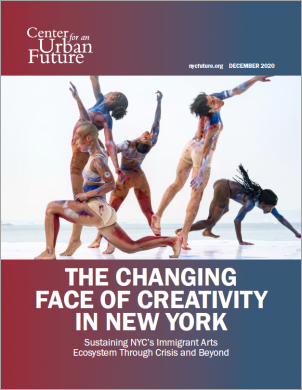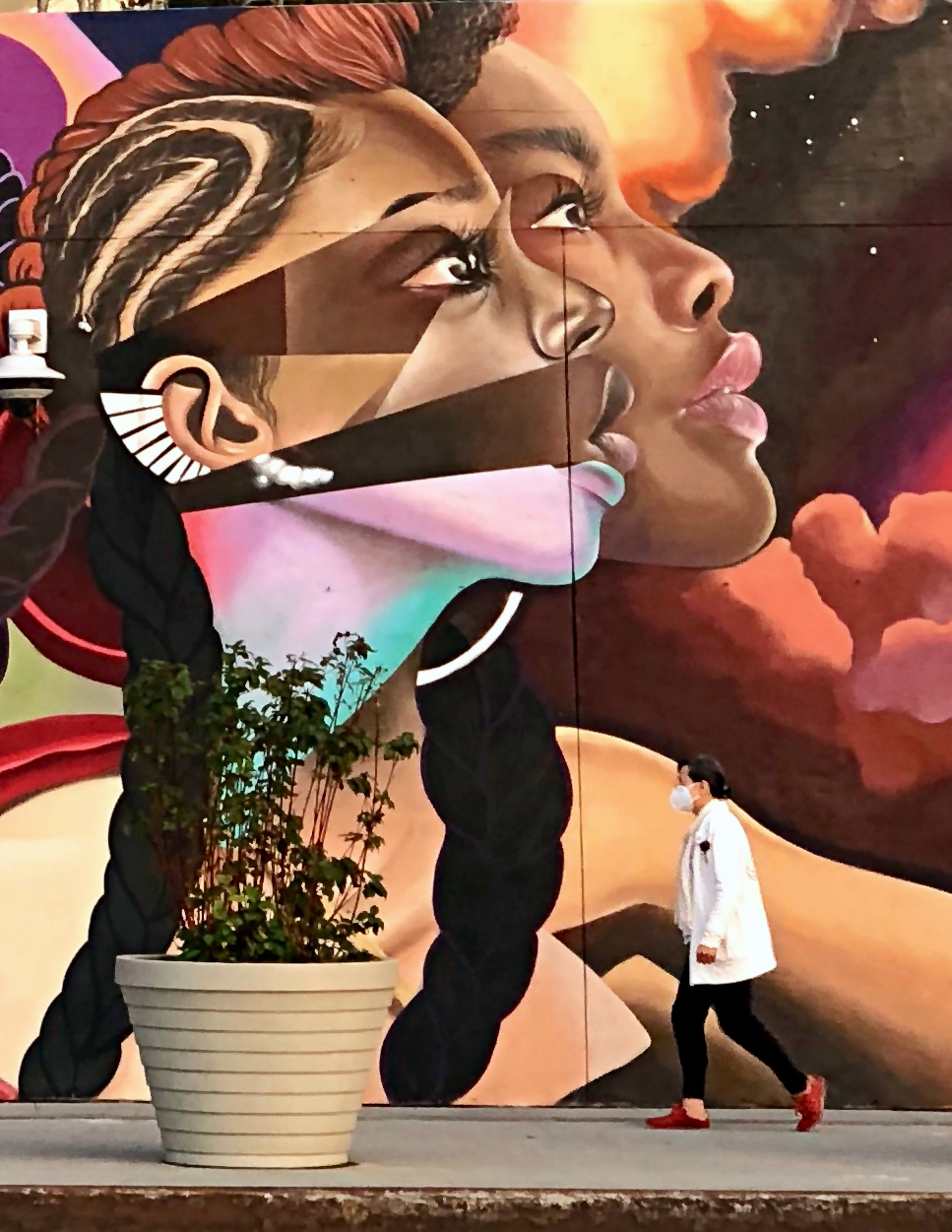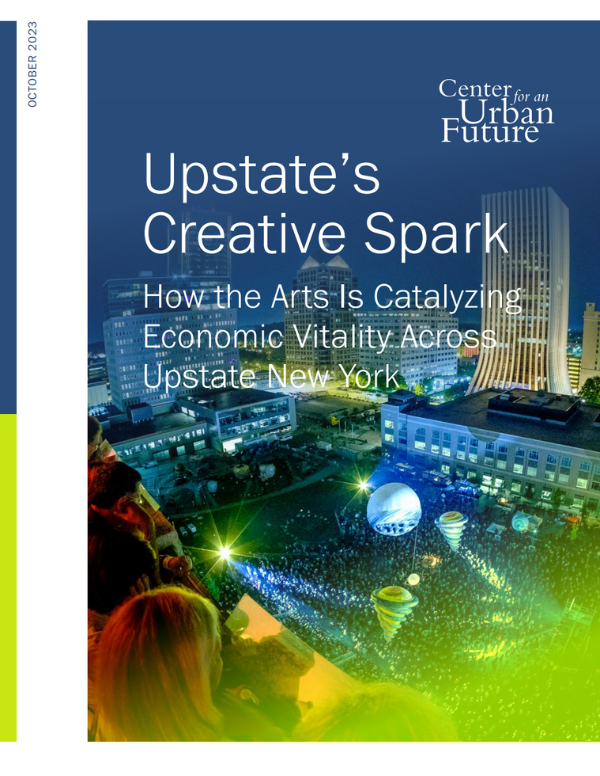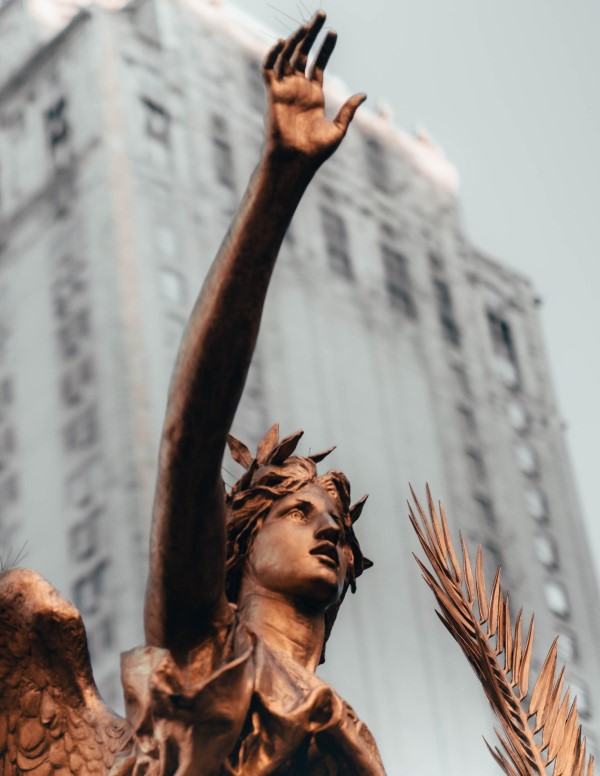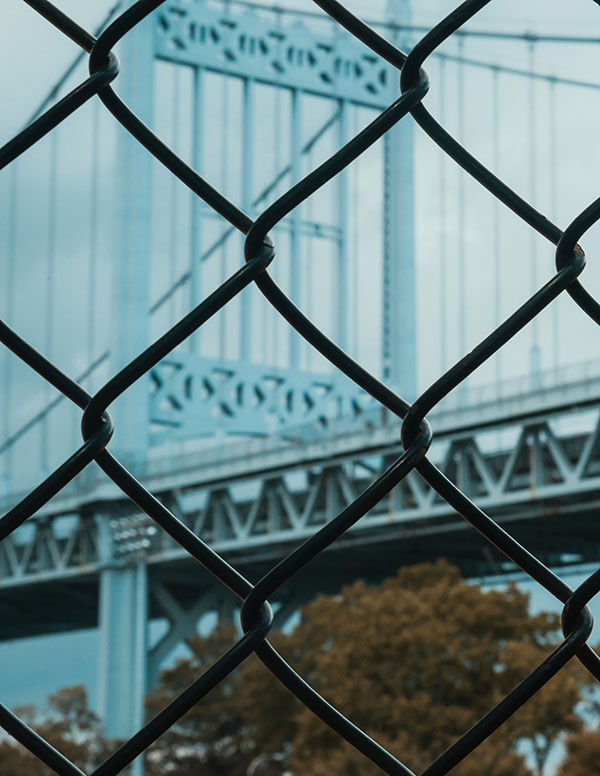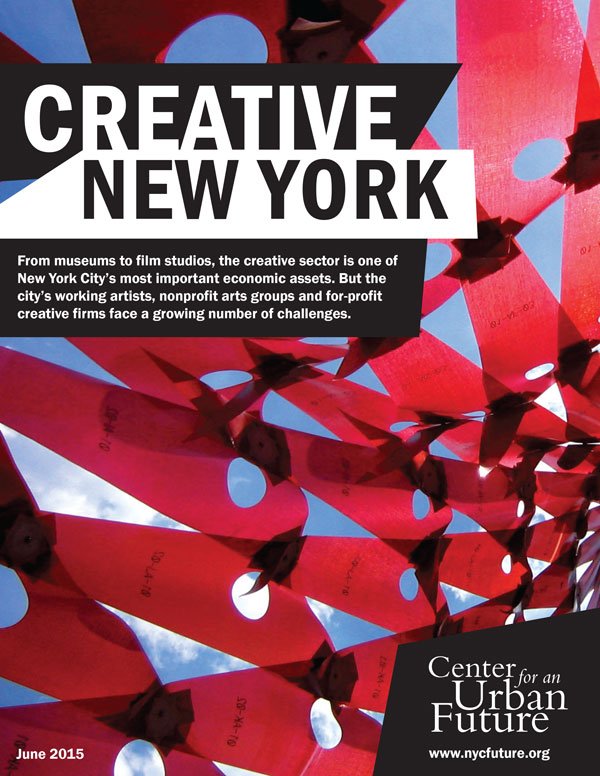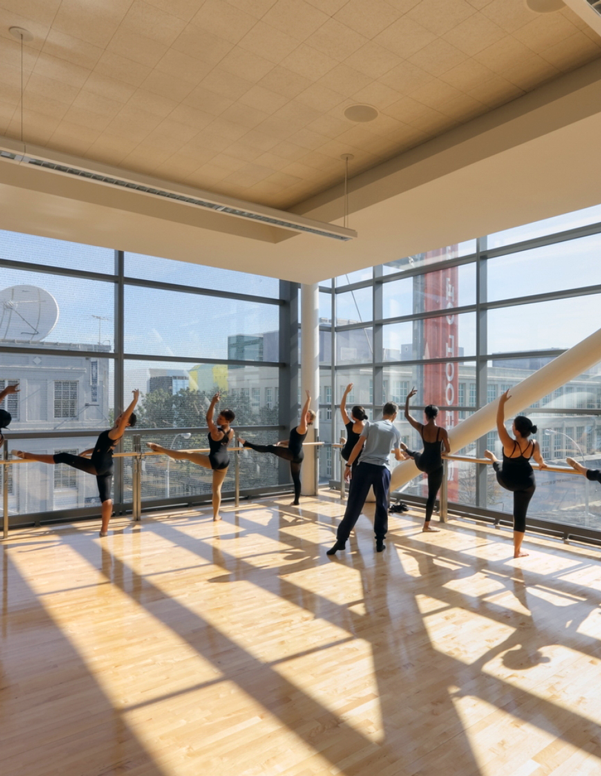- The following are recommendations from The Changing Face of Creativity in New York: Sustaining NYC’s Immigrant Arts Ecosystem Through Crisis and Beyond
- Read the full report (PDF)
1. Step up city funding and support for immigrant-serving arts organizations. New York City’s FY 2021 budget cuts pose enormous challenges for immigrant arts organizations. The budget slashes more than $23 million from the Department of Cultural Affairs and cuts City Council discretionary spending by $79 million—sources of funding that many immigrant arts organizations rely on. At the same time, New York City’s immigrant arts ecosystem has been devastated by the COVID-19 pandemic, and relief is needed urgently. But the city’s bleak fiscal outlook means that policymakers will need to find creative ways to boost support for immigrant artists by expanding access to public spaces, eliminating restrictions on current funding, scaling up volunteer efforts, tapping the private sector and philanthropy, and taking advantage of the unique opportunities that an economic downturn presents.
- Launch a major new Immigrant Arts Relief Fund to address the ongoing COVID crisis. Immigrant-led arts organizations, especially those which are unincorporated and/or operating within historically marginalized communities, were already struggling before the pandemic hit and face multiple barriers to accessing public funding. To ensure that the city does not lose a significant share of its immigrant-serving arts organizations, a major relief effort will be needed. Mayor de Blasio and the City Council should work with philanthropic foundations and business leaders to launch a new $10 million Immigrant Arts Relief Fund, partnering with intermediary organizations that have deep reach and trust within immigrant communities to distribute the funds. This initiative should include legal technical assistance for organizations administering relief funds to ensure that grant recipients are not put at risk with regard to immigration status. As the economy recovers, this program should convert into an ongoing Immigrant Arts Development Fund, focused on institutional advancement, capacity-building grants, and general operating support.
- Expand access to public open spaces for immigrant-serving arts organizations. After months without any earned revenue, many of the city’s small, immigrant-run and -serving arts organizations are on the brink of fiscal collapse. One way that the city can help is by opening up public spaces—from parks and streets to the parking lots under the BQE and the Metro-North—for paid performances, workshops, screenings, and events. With most venues closed and the looming threat of a second wave of infections, immigrant artists need outdoor spaces to work, perform, and earn income, and the city has no shortage of spaces to make available. This initiative should tap the ingenuity of the city’s architects and designers—many of whom are themselves immigrants—to design windbreaks, temporary shelters, outdoor heating solutions, portable stages, and other structures that can allow outdoor spaces to be used by artists throughout the year.
- Partner with technology firms to provide infrastructure and know-how to support virtual programs. Many small arts organizations struggle to pay for technology like laptops, projectors, and other equipment that facilitates both creative work and important administrative tasks—as well as the shift to virtual programming demanded by the pandemic. However, the city only supports equipment costs through a capital grant in which the equipment must cost no less than $50,000. The city should launch a new program in partnership with leading technology firms to help small arts organizations create income-generating virtual programs, build capacity to reach audiences digitally, and document cultural traditions through digital media.
- Strengthen the power and reach of Borough Arts Councils by increasing direct support for artists, raising the cap on regrants, and expanding outreach via trusted intermediaries. Our research found that borough arts councils are well-positioned to support immigrant arts, especially through their regranting programs and specialized outreach. However, despite increased overall funding, council regrants are capped at just $5,000. By raising the cap to $10,000, councils could greatly increase support to individual immigrant artists and collectives who cannot directly access other city grant programs. Lack of awareness and language barriers also prevent many immigrant artists and collectives from participating in council regranting programs. The city, state, and philanthropy should work together to ensure that all five arts councils are funded to operate a standalone Folk Arts program and hire an administrator dedicated to immigrant community outreach. In addition, each borough’s council should partner with at least one local intermediary organization focused on immigrant arts to assist smaller organizations with fiscal sponsorship, grant writing, and other technical services.
- Make Cultural Development Fund (CDF) grants more flexible to reach immigrant arts organizations. DCLA’s requirements for CDF grants limit the program’s ability to reach many of the city’s most vulnerable immigrant arts groups. Cultural projects in immigrant communities often work outside the 501(c)(3) structure—a requirement for CDF funding. The program’s requirement of two years of financial documentation poses an additional barrier, and recently incorporated organizations must wait two years just to apply. DCLA should relax these requirements, expand eligibility to fiscally sponsored projects, and provide groups with guidance on finding a sponsor. Launching more flexible, responsive CDF funding will enable DCLA to better reach vital organizations that lack the resources to formalize.
- Expand the Language Access Fund, with increased translation support for immigrant-serving organizations. Nearly half the population of New York City speaks a language other than English at home. By making the Language Access Fund a standalone program, DCLA has recognized its great potential to improve access to cultural programming for New Yorkers whose primary language is not English, but it funded just 36 grantees in FY2020, compared to over 900 organizations funded through the Cultural Development Fund (CDF). DCLA should preserve and ultimately expand the Language Access Fund so that more arts organizations, especially immigrant-led and primarily immigrant-serving organizations, can improve access through multilingual programming, translated materials, and interpretation services.
2. Establish Immigrant Arts Centers in all five boroughs as part of a long-term recovery plan. Neighborhoods with large immigrant communities often lack permanent, affordable arts spaces. Recognizing the need for dedicated space for arts and culture for Inwood’s large immigrant community, DCLA and NYCEDC committed $15 million in funding for the design and construction of the Immigrant Research and Performing Arts Center (IRPAC). DCLA and NYCEDC should develop plans for Immigrant Arts Centers in historically underserved, predominantly immigrant communities in the Bronx, Queens, Brooklyn, and Staten Island, which could form the centerpiece of a long-term economic recovery strategy.
3. Launch a citywide initiative to help immigrant artists and arts organizations fill the growing number of storefront and commercial vacancies. While the growing number of vacant storefronts presented a policy challenge—and an opportunity—even before the COVID crisis hit, the continued fallout from the pandemic’s economic impact is likely to further increase the supply of storefront and commercial spaces for the foreseeable future. New York City should launch a new initiative to connect artists and arts organizations with vacant commercial space in their communities—focusing on underresourced and immigrant-serving arts groups and working artists. New York should develop a standardized temporary lease agreement, work with a partner organization to develop a simple online application and map of available spaces, and incentivize landlords to participate by providing a property tax credit through the duration of the residency.
4. Create a NYC Immigrant Artist Film, TV, and Theatre Fund with seed money from the industry. In 2018, the Mayor’s Office of Media and Entertainment (MOME) launched the $5 million Women’s Fund, a major new investment supporting film and theatre projects by, for, and about women. The fund, designed to address the underrepresentation of women in film, TV, and theatre, has already invested $1.5 million to support more than 60 women-led projects with cash grants of up to $50,000. MOME should replicate the fund for foreign-born creatives, with the analogous goal of addressing underrepresentation of immigrants in the film, TV, and theatre industries by providing much-needed financial support. Given the huge fiscal challenges facing the city, such a program could be seeded with funding from major content studios and distributors, or funded by a small surcharge on film and tv production permits.1
5. Leverage underutilized city-owned spaces to provide immigrant artists with affordable work space in their communities. As New York City’s affordability challenges have grown in recent years, many artists and creative professionals report struggling to find space to practice their craft. The city should look to extend affordability initiatives with specific focus on immigrant artists. To get creative in a time of fiscal constraints, the city should leverage underutilized, city-owned spaces, most notably in city schools. Many schools in neighborhoods with growing populations of immigrant artists have arts spaces, such as visual arts rooms, music rooms, theatres, dance studios, and even film production facilities, that go unused in off-hours and over the summer. These spaces could provide much-needed work space to immigrant artists while strengthening and diversifying arts education and exposure. A partnership between DCLA and city schools could be an important component of a citywide strategy to support immigrant artists, tackle the affordable space crisis, expand access to arts education in multiple languages, and help connect artists with their communities. In addition, the SU-CASA program, which places artists and arts groups in residence at senior centers across the city—enhancing arts programming for older adults and promoting community arts engagement while providing artists with much-needed workspace—provides a proven model that the city can build on. But this program’s budget was slashed by nearly $2.3 million in FY 2021—a roughly 70 percent cut—and should be restored.
6. Expand legal assistance programs to support immigrant artists and arts organizations. Undocumented artists confront perhaps the greatest barriers to making a living as an artist in New York City, facing significant eligibility restrictions when it comes to funding and work opportunities. Temporary worker artists and artists fleeing persecution also face legal difficulties—and expenses—in securing visas to stay in the U.S. and practice their art. DCLA should partner with the Mayor’s Office of Immigrant Affairs (MOIA) to launch a new program specifically designed to support immigrant artists, including but not limited to undocumented artists, foreign-born arts students seeking to stay in the city upon completion of their degree, and artists who have faced persecution for creative expression in their home countries. DCLA and MOIA should also develop a new training program to help major cultural institutions as well as smaller arts organizations hire and/or work with undocumented or temporary status individuals.
7. Take advantage of the downturn to help immigrant-led arts organizations band together to secure permanent spaces. Because immigrant-led organizations are much less likely to own their spaces, they have been especially hard-hit by rising rents and the disappearance of affordable rental space for production, rehearsal, and performance. The city should take advantage of a softer real estate market and mortgage rates that are near record lows by bringing together small immigrant-led cultural institutions that can pool resources to purchase buildings and establish permanent, shared office, rehearsal, and performance space. In addition, government can help by establishing a new program to provide help with closing costs for arts organizations seeking to purchase space, potentially by forgiving the mortgage recording and/or transfer tax or a portion of future property taxes.
8. Expand NYC Community Land Trust Initiative to artists and arts organizations. In 2019, the City Council pledged $870,000 in funding to support the creation of community land trusts (CLTs) across New York City. This major investment in technical assistance, educational outreach, and organizing will give communities control over the development of permanently affordable housing, commercial space for local worker cooperatives and small businesses, and space for community organizations. But with focused leadership, the CLT model can be expanded to support the development of more community arts and culture spaces, as well as spaces where immigrant artists can both live and work.2
9. Market immigrant arts organizations and programming to New Yorkers and visitors as part of the city’s tourism recovery efforts. As New York begins the long process of rekindling the city’s devastated tourism economy, immigrant arts should play a leading role. While the city’s tourism marketing agency, NYC & Company, has taken several steps in recent years to direct visitors to more off-the-beaten-path attractions and locations, the bulk of the city’s tourism promotion has remained focused on Manhattan and major cultural institutions in the other four boroughs. The city should set a goal of greatly expanding the representation of immigrant-focused arts experiences in tourism marketing efforts and use the “All in NYC” campaign as an opportunity to encourage New Yorkers to visit and support immigrant-run and -serving galleries, performance spaces, festivals, public art projects, creative small businesses, tours, parades, open studios, and other events. These efforts could be bolstered through the creation of an Immigrant Arts Week, as well as expanded public support for cultural festivals from Diwali to the Lunar New Year.
10. Help immigrant creatives start and grow their businesses. Immigrant creative entrepreneurs face specific challenges in running successful small businesses—from language barriers and difficulties accessing capital to challenges building a customer base outside their communities. The Department of Small Business Services (SBS) and NYCEDC should build on current initiatives intended to aid immigrant entrepreneurs, including the Immigrant Business Initiative and the Etsy Craft Entrepreneurship Program, and ramp up support for immigrant creative businesses. The city should work with social impact investors to provide seed funding to 500 immigrant-run creative business ventures as part of the city’s economic recovery efforts; launch new spotlight programs focused on immigrant creators during NYCxDESIGN, the New York Film Festival, New York Fashion Week, and major art fairs like the Armory Show and Frieze; partner with a technology company to provide digital marketing grants to immigrant creative businesses; and expand the Craft Entrepreneurship Program to more immigrant communities through partnerships with the city’s public libraries.
11. Increase support for rehearsal space subsidy programs. Despite recent declines in artist rehearsal and work spaces, there are still many facilities available—they’re just not affordable to the vast majority of artists and performers. This affordability crunch can be alleviated in part through targeted subsidies. Successful initiatives such as NYSCA’s Dance Rehearsal Space Program, which provides grants to facilities offering 1,000 hours of subsidized rehearsal time at $10 or less per hour, should be replicated for music, theater, and studio arts. The city should also fill the void left by the recent closures of Spaceworks and Exploring the Metropolis and the loss of the SpaceFinder website, and launch new partnerships with landlords, educational and cultural institutions, and real estate developers to provide affordable work and rehearsal spaces at below-market rates, with a focus on immigrant communities.3
12. Strengthen partnerships between immigrant-led arts organizations and city schools. As part CreateNYC’s goal of providing high quality arts education to all public school students, the city pledged to connect public schools to local cultural organizations, with the goal of providing culturally resonant and responsive curricula. But so far, the pilot has been limited to one Department of Youth and Community Development program with the American Museum of Natural History. DYCD and DOE should work together to expand opportunities for bilingual, indigenous, and immigrant teaching artists from non-Western traditions to acquire certification to teach in city schools. City agencies should collaborate with borough arts councils and grassroots intermediaries to connect schools with artists and arts organizations in their neighborhoods, bringing immigrant artists and collectives into classrooms and DYCD-administered Cornerstone and Compass centers.
13. Mobilize philanthropic support for a CUNY Creative Careers Impact Fund. In 2016, CUNY, DCLA, and the Rockefeller Foundation launched the CUNY Cultural Corps, placing 85 CUNY students in paid internships at 32 cultural institutions throughout the city. In 2019, the program placed over 100 students at more than 45 cultural nonprofits, increasing opportunity in the cultural sector and helping to create a more diverse and inclusive cultural workforce. With additional philanthropic support in the form of a major new impact fund, the program could support paid internships at smaller organizations, host art meetups, and bring more cultural career support onto CUNY campuses, strengthening bonds between CUNY and the city’s cultural community.4
14. Address funding inequities across the Cultural Institutions Group (CIG). Immigrant-serving cultural institutions, including those in the Cultural Institutions Group, receive significantly less funding than more mainstream peers, greatly impacting their ability to expand outreach into the communities they serve. Of the ten CIGs that received less than $1 million in city funding in FY 2020, two are located in neighborhoods with large immigrant populations (Flushing Town Hall and the Queens Theatre), while another two are located in neighborhoods with large non-white populations (Bronx County Historical Society and the Bronx Museum of the Arts); a fifth, the Jamaica Center for Arts and Learning, serves a population that both has a large immigrant population and is largely non-white. While DCLA funding mechanisms such as the CDF have broadened cultural funding, the city should set a goal of doubling funding for smaller CIGs in communities of color.
15. New York’s leading cultural institutions should implement sanctuary space training and deepen ties with local immigrant arts groups. In today’s political climate, fear is keeping many immigrant artists and audiences away from mainstream cultural institutions. Even if they cannot commit to serving as sites of refuge, museums, theaters, and other cultural institutions can still adopt policies that make their spaces safer for immigrant audiences and staff and should work with local advocates and organizations to do so. In addition, the city’s flagship cultural institutions can support an inclusive recovery for the arts by seeking out programmatic partnerships with the city’s thousands of community-based, immigrant-serving arts organizations and committing to increasing the representation of immigrant curators, artists, performers, and staff across all levels of the institution.
Notes
1. Mayor’s Office of Media and Entertainment, “Women’s Film, TV and Theatre Fund.’
2. The New Economy Project, “NYC Takes Bold Action to Address Affordable Housing Crisis by Supporting Community Land Trusts,” June 25, 2019.
3. NYSCA, “Dance Program Guidelines FY 2021.”
4. CUNY, “As CUNY Cultural Corps Enters Its Fourth Year, NYC Department Of Cultural Affairs And CUNY Announce New Permanent Public Funding,” September 17, 2019.

